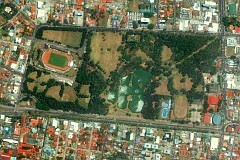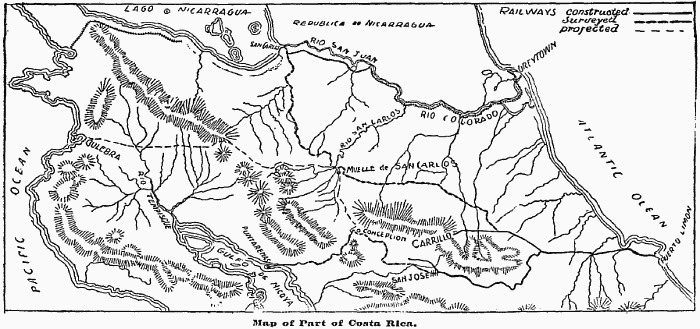The New York Times, September 3, 1893, p. 17:
COSTA RICA'S CAPITAL CITYTHE PLACE EMBEZZLER WEEKS CHOSE TO HIDE IN.
Beautiful Environments of San Jose,
4,000 Feet Above Sea Level and Surrounded by Mountains--
A City of Chivalrous Men and Beautiful Women,
Devoted to Fine Arts and Paris Fashions--
Hospitable to Accredited Strangers--
Routine Life in the Tropics--Hotel Life in Costa Rica.
The City of San José de Costa Rica is built on a lofty mesa or plateau, nearly 4,000 feet above sea level. It lies in a natural amphitheatre, surrounded by foothills and mountains.
The mesa is not as extensive as that on which stands Guatemala City, in the republic of that name. The "Athens of Central America," while having three to four times the population of San José, has a greater resemblence to a city on a plain.
In San José the foothills are nearer, and the lofty mountain ranges are just back of them. The capital of Costa Rica has long been known and famed for the classic beauty of its surroundings and the grandeur of its mountains. They lift their peaks skyward, and extend in all directions, as far as the eye can reach.
The highlands of Costa Rica have been invaded by American enterprise. The capital is lit by an electric light plant from New-York City, the arc system being used for the streets and the incandescent for hotels and residences. Another evidence of Costa Rica's push and energy is shown in the tram-via, or street cars. They connect several parts of the city with the railway station. American models and methods are popular in the sunny republic.
While Costa Rica is rich in soil, climate, and scenery, it is also known for its charming and cultivated society. Nowhere in Central America is real intellectuality more marked. In fact, travelers state that San José de Costa Rica is the most polished and courtly centre in Central America.
The educational standard for youth is high. Fine art receives great attention. As a natural result art and music find a home in the congenial clime. The fine Opera House during the "season" receives many European opera companies, and the audiences will compare favorably with those of New-York, London, and Paris.
And these audiences, too, sustain the proud boast of Costa Rica of the beauty of her daughters, many as fair and charming as their sisters in distant Andalusia in the mother country. In San José the blonde and brunette types can be contrasted, the brunettes with black hair, pearly-white teeth, and jet-black eyes that can be as placid as a Sabbath morn or flash fire, as only Spanish eyes can.
The welcome accorded a stranger to scenes and surroundings so attractive, when the visitor is properly accredited, is instant and warm. The tropics have a world-wide fame for hospitality, and nowhere will it be found in more attractive form than in Costa Rica.
A few words regarding Spanish-American etiquette may be in order. In the matter of calling it is just the reverse of English and American practices. The new-comer makes out his visiting list and either calls in person or sends his card to all those whose acquaintance he desires to make. The stranger makes the first call. A return call or sending a card is de rigeur. Should the new-comer make a second call it then rests with the residents to follow up the acquaintance or drop it. After having stayed a time, or when leaving the country, many publish a card in the newspapers, called a "Despidida," a species of farewell, in which Señor Fulano de Tal--or Mr. Smith--places himself at the disposal of his friends in New-York, London, or Paris, as the case may be, when friends can ask him to make endless purchases.
In matters religious the Costa Ricans are Roman Catholics, that being the dominant faith in all Spanish America.
Observant travelers are at once impressed with the natural grace and refinement of the upper classes. There is a polished case and courtesy that no pen sketch can do justice to. Perhaps it is best described by saying that it is the French etiquette of the time of the Empire, somewhat accentuated. Another thing will impress the stranger; it is the universal and courtly address paid women. For them it is a veritable paradise, a royaume des femmes. In all Spanish America the Spanish form of direct and personal compliment obtains and is strictly good form. A gentleman will publicly congratulate a lady on a well-fitting Parisian robe or hat. If the fortunate possessor of fine eyes, he may say: "Que ojos magnificos"--"what magnificent eyes." It always pleases and is admissable. This open and direct style of compliment in our centres probably would lead to trouble. They are a remarkably sensible lot of people, and do not take life as seriously as we do. They know full well that a few polite phrases are indicative of a kindly heart and true refinement. Hence they are current coin, and no none but a boor would take exception to them. Under truly tropical skies our every-day commonplaces seem lost.
When European-bred women visit Costa Rica they are reminded of courts and cities of the true Continental type. It seems superfluous to add that it has a great charm for strangers. The Capital is very cosmopolitan. It is said that fully a fourth of its residents are Colombians and Nicaraguans from the adjoining republics, respectively, to the south and north.
Already reference has been made in these columns to the architecture that obtains in Costa Rica. It constantly reminds the visitor of that in Spain--an architecture that in its mother country has received a lasting impress, caused by sad years of Moorish occupation of the Iberian peninsula... the "globe trotter" will find it to-day not only in Spanish America, Cuba, and Puerto Rico, but in Jamaica as well--a modification of the luxurious style of Moorish building eminently adapted for the tropics, giving stability, shade, and consequent coolness.
The every-day life of the upper classes may be very briefly summarized. The early morning meal--Continental fashion--consists of coffee and rolls, and perhaps some dulce or sweet. Such coffee! Not one in a thousand knows a good cup of coffee. Costa Rica grows a coffee berry famous in the London markets. Breakfast at 11 or 12--à la fourchette--meats, game, vegetables, vin ordinare, ending with queso y jalea, or cheese and guava jelly. It is a Spanish American custom, met with also in Cuba and Puerto Rico.
For purposes of business and professional work the morning hours are the best. They are the coolest. After breakfast, the midday siesta or rest. Generally it means a nap--an hour or two taken from the day. After it, the cigarette and getting ready for the afternoon. Dinner at 6, 7, or 8, as the case may be. Dining there is a fine art, and the meal is taken in a leisurely, philosophic way, and nothing is allowed to interfere with its continuity. When people are comiendo--or dining--any intrusion is very bad form, in fact, unpardonable. Later, calls and receiving visitors is in order. Informal calling, as we know it, by strangers is not good form. That is exclusively for relatives and intimate friends.
Turning to hotel life, El Gran Hotel just now has taken on new fame, as being the temporary repose of Mr. Weeks, the New-York embezzler of $1,250,000 belonging to women. The meals in hotels are served at about the hours already noted. The hotel table presents an endless variety of dishes, largely Spanish and French. There is everything and anything from bacalao, or codfish, to jalea, or jelly, meats, game, and a great variety of tropical fruit. In some of the hotels the dining tables are placed in an alcove near the patio or central court, well away from all sunshine and glare. Oftentimes the courts present a wealth of tropical plants--ferns, palms, and flowers. M. Victor wasn an early-day famous caterer. Needless to say he was a Frenchman.
Apropos of things French, French dresses, hats, and dainty shoes are à la mode. Paris gives the fair ones their fashions--Mother Eve's daughters are much the same in all climes. Indeed, all Central Americans have a marked liking for France. Many Costa Ricans and Central Americans educate their children abroad. When Spanish Americans speak two languages--and herein they are dealt with collectively--the second language is French. It is a first cousin of their own sweet, musical toungue. The Spanish language has a marvelous flexibility and a music all its own.
In closing, a brief glance at Central America may be in order. To-day it is composed of five republics, whose Constitutions are popularly supposed to resemble that of the United States of America. They are Costa Rica, Nicaragua, Salvador, Honduras, and Guatemala, named in their geographical order, proceeding north from the Isthmus of Panama. While a Spanish possession they were one and known as the Vice Royalty of Guatelmala. Spain is not a popular theme in Spanish America. In all Central America they speak and write of the Spanish yoke. The Central Americans effected their independence in September, 1821. La Independencia was followed by a form of federal government. After several years of civil war, the Confederate States resolved themselves into republics, as already named.
The total area of Central America, including British Honduras, is estimated at 175,867 square miles, with a population of over 3,000,000, of whom perhaps a fourth are white, or oreoles of European descent, the remainder Indians and their descendents. The nearness of Central America, the Nicaragua Canal--a commercial necessity--as well as the valuable trade developed by an American corporation, the Pacific Mail Steamship Company, give the whole an interest essentially American.
|
| | |
see also: Panama News - Nicaragua News - Guatemala - El Salvador
|
|
All of Costa Rica is one
time zone at GMT-6, with
no Daylight Savings time.
|
Costa Rica News
Although explored by the Spanish early in the 16th century, initial attempts at colonizing Costa Rica proved unsuccessful due to a combination of factors, including: disease from mosquito-infested swamps, brutal heat, resistance by natives, and pirate raids. It was not until 1563 that a permanent settlement of Cartago was established in the cooler, fertile central highlands. The area remained a colony for some two and a half centuries.
In 1821, Costa Rica became one of several Central American provinces that jointly declared their independence from Spain. Two years later it joined the United Provinces of Central America, but this federation disintegrated in 1838, at which time Costa Rica proclaimed its sovereignty and independence. Since the late 19th century, only two brief periods of violence have marred the country's democratic development.
Although it still maintains a large agricultural sector, Costa Rica has expanded its economy to include strong technology and tourism industries. The standard of living is relatively high. Land ownership is widespread.
CIA World Factbook: Costa Rica
Area of Costa Rica:
51,100 sq km
slightly smaller than West Virginia
Population of Costa Rica:
4,133,884
July 2007 estimate
Languages of Costa Rica:
Spanish official
English
Costa Rica Capital:
San Jose
SAN JOSÉ WEATHER
Costa Rica Reference Articles and Links
Wikipedia: Costa Rica - History of Costa Rica
BBC Country Profile: Costa Rica
US State Department: Costa Rica Profile
Embassy of Costa Rica, Washington, D.C.
WikiTravel: Costa Rica
Costa Rica News Websites
Tico Times
Nacion in Spanish
La Republica in Spanish
Diario Extra in Spanish
El Financiero in Spanish
Repretel TV 4, 6, & 11 in Spanish
Teletica TV 7 in Spanish
ABYZ: Costa Rica News Links
|

